
How to Write High-Converting Landing Pages for Facebook Ads in 2018
Complete Guide on the Psychology Driving High-Converting Landing Pages + 4 Detailed Case Studies feat. Sam Ovens, Jon Benson, Josh Forti, and Dan Bilzerian
This is a follow up to my popular Facebook advertising guide for entrepreneurs. I got a lot of great feedback from that article, the most popular being what about after the Facebook ads?
So today we’re going to talk about building landing pages.
You’re going to learn the essential psychology behind landing pages that sell thousands of dollars of product today.
Then we’re going to look at 4 case studies together. Whether you’re trying to generate leads for your business with a free content offer (like a webinar or a report), sell a product for less than $100, or sell high-ticket services over $1,000 — you’re going to be covered in this guide.
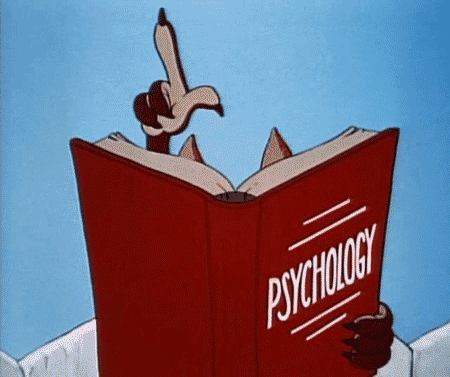
Essential Landing Page Psychology
Before you worry about how to create a landing page for your offer, you’ll find it helpful to understand the essential psychology that powers high-converting landing pages.
Taking the time to understand these brief marketing principles will drastically speed up your time creating landing pages for your own products and services.
The 6 Principles of Influence
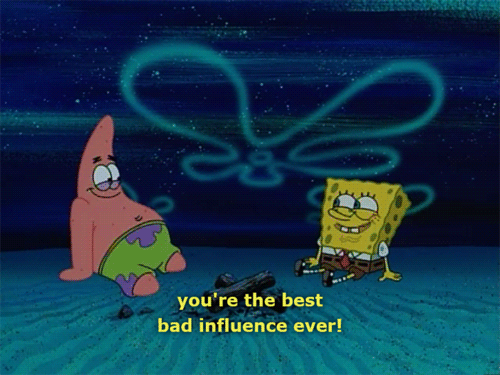
Dr. Robert Cialdini is a professor and researcher who developed arguably the first in-depth theory about Influence. The 6 point framework is detailed in his seminal work Influence, where he spent 3 years “undercover” applying for and training at used car dealerships, fundraising organizations, and telemarketing firms to observe real-life persuasion situations.
This article is not another rehash of his work. You can read a lot more about each influence principle in detail in his book.
There are enough crappy articles that essentially summarize the entire book. This isn’t one of them.
I am going to briefly overview the 6 principles with you so that you can have a general understanding of each one. Then you’re going to see how each of these 6 principles is applied to a real-life case study landing page.
Influence Principle #1: Reciprocity
The reciprocity principle is simply that people tend to return a favor.
A popular example of the “reciprocity” principle is the discount.
When you see a tag with $100 crossed off and replaced with a $50, you feel like the store is “giving” you $50. If they’re willing to make a concession on price for you, you feel more obligated than before to buy the thing.
A popular tourist scam that relies on the reciprocity principle is the “gift” scam.
This scam takes MANY forms and is seen all over the world, but it essentially revolves around someone approaching you and giving you beads, a friendship bracelet (sometimes they make the bracelet right on your arm), a ring they “found”, a pin…
Essentially the person “gives” you a “gift”, and then they promptly (or after some chit-chat) demand money from you.
Because the [whatever gift] is now in your possession (you might even have to take it off), you now feel the need to reciprocate with payment…
This reciprocity principle will be very prominent in the case studies we’re about to look at.
Influence Principle #2: Commitment & Consistency
This influence principle seems a little abstract from the name, but all it means is that people like to take actions that reflect how they see themselves.
As an entrepreneur, I’m sure you’ve seen many website popups that say something along the line of “No thanks, I prefer not to make money” when you want to close it.
These kinds of popups rely on the fact that business owners think of themselves as people who want to make money. It’s inconsistent with how you view yourself to say “Nah, I don’t want to make money thanks”, that’s what makes it feel hard to turn down.
Influence Principle #3: Social Proof
You’re probably already familiar with the social proof principle of Influence. It’s going to be a BIG point in the 4 case studies we’re going to look at after this.
The reason why we can sometimes be susceptible to social proof, is because it’s a very useful survival strategy!
If you’re a nomad exploring a new area, and you’re running low on supplies. Maybe you’re malnourished. If you see some healthy-weight people walking away from an area, aren’t you going to check it out?
Of course you will!
When you need something, but you don’t know how to get it, an easy shortcut is to look for other people who have [the thing you want] and do what they do.
Influence Principle #4: Authority
Slightly related to the social proof principle is the authority influence principle. Again, this principle is going to be a BIG player in the 4 landing page case studies below.
You’re probably familiar with authority being used to influence you like this:
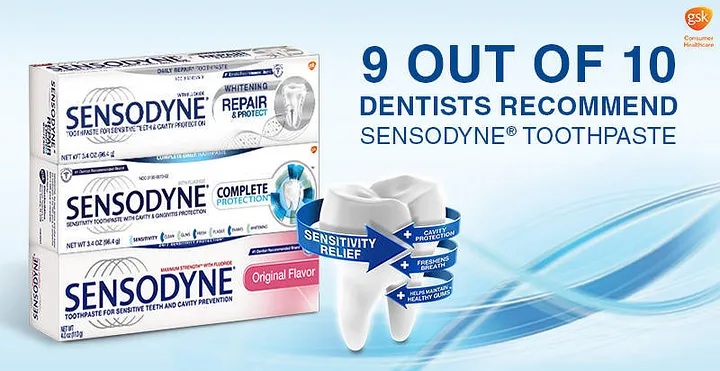
And this:

But the truth is that your willingness to obey authority figures goes even further than that. Often, all it takes to get you to do something is for the authority figure to ask you to do it.
Dr. Cialdini talks about the Milgram experiments in Influence, where participants were asked to deliver and increasingly more painful level of electroshocks to another person by the researcher. A shockingly high proportion of people would fully obey all instructions, and not question delivering increasingly painful electroshocks — even if following the directions made them uncomfortable.
Another popular psychological study that explores the relationship of authority to behavior is the Stanford prison experiment.
This experiment looks at how participants will exercise authority against others. Many prisoners passively accepted psychological abuse from the “guard” authority figures, and also harassed other prisoners simply at the request of guards.
You can see the Stanford prison experiment recreated in many TV shows, like in Season 3 Episode 2 of Veronica Mars:
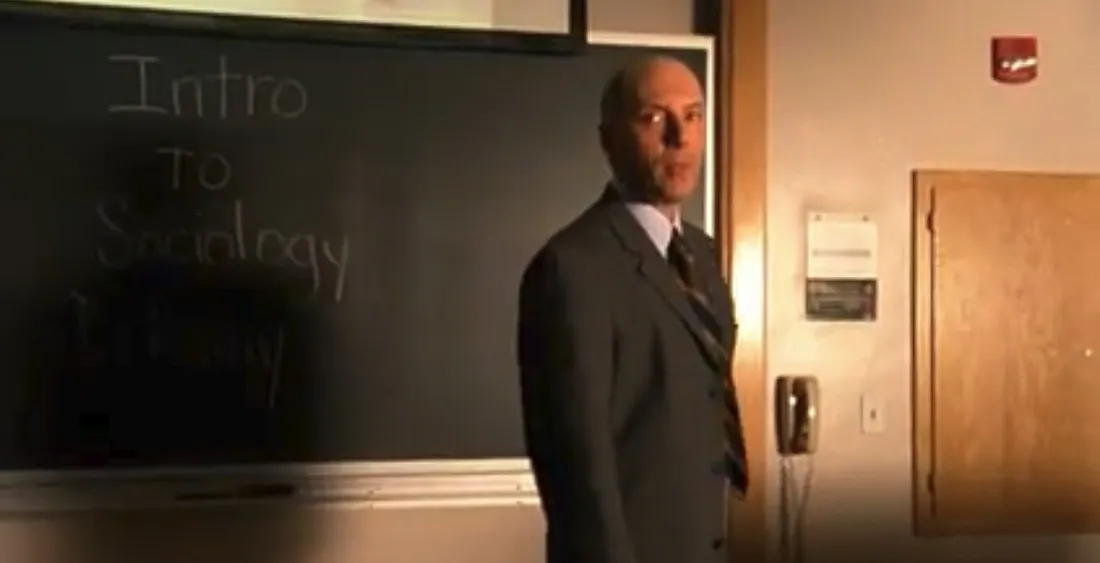
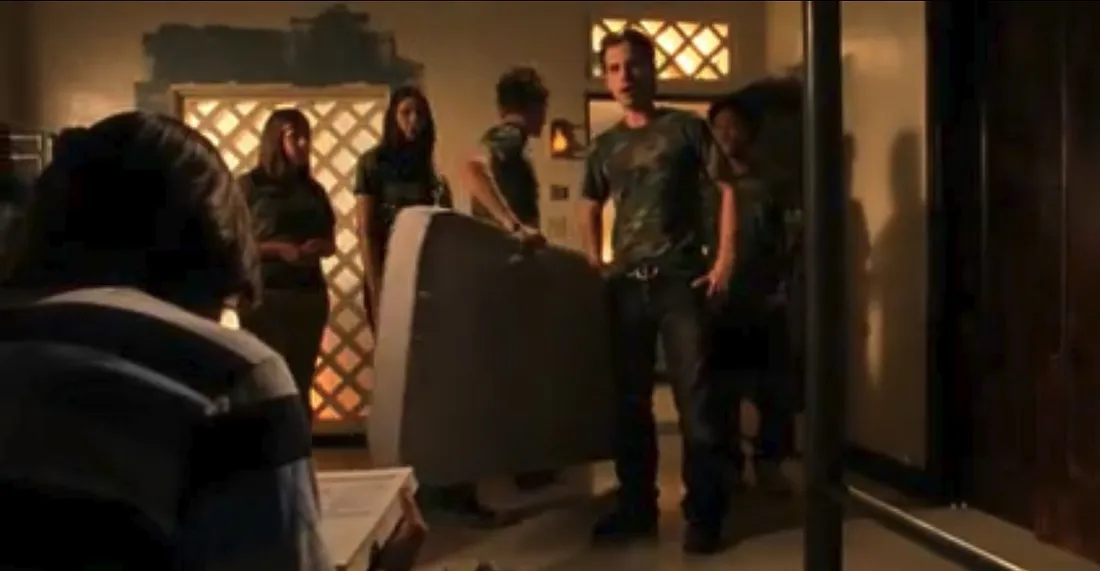
Influence Principle #5: Liking
People are more easily persuaded by other people that they like.
The liking principle explains the near-viral spread of MLM businesses like Tupperware, Mary Kay, Herbalife, and others.
Some of the ways that the liking principle is used to influence in marketing is by using models that are similar to the target demographic. Because people like what is similar to them!
The hot “conversational copy” trend capitalizes on the liking principle by trying to gear marketing messaging close to the natural language prospects use to describe their problem in their own words.
Influence Principle #6: Scarcity
This is probably another principle that you’re already familiar with, but why does scarcity exist?
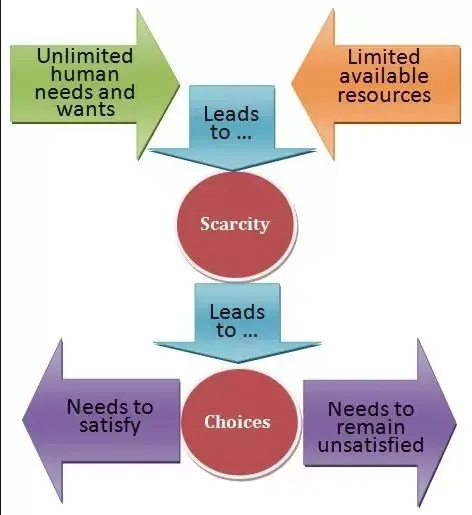
Essentially, you can’t always get what you want. Your capacity to want stuff is basically unlimited, but there’s only so many things on the earth that you can have.
Not only are all of the things limited, but you also have limits on your time, money, space to hold stuff, etc that affect your ability to consume.
If you can create the perception that not everyone who wants this can have it, it can trigger demand.
This is a principle that almost all luxury brands capitalize on. Buying a Mercedes, or a Coach bag, or whatever lets you into “the club” that not everyone can be in because of the high barrier of entry.
Having something that others don’t is desirable because it makes you feel good.
One of the most famous example of the scarcity principle at work in the luxury industry is the Birkin bag.
This French luxury purse brand has been the “it” bag for decades because of how effectively it restricts the supply of its products.
It’s not easy to find Birkin bags.
The supply is limited. Stores that “carry” Birkin bags are frequently sold out. You may even have to find a private consultant to score a Birkin bag.
You can follow one woman’s journey to score a Birkin and all of its hassle here:
I highly recommend giving that above Planet Money episode a listen to really get an inside view of the psychology that drives people to hunt down these ugly (at worst, or totally average looking at best) purses.

Despite ALL of that hassle, the bags average $60,000.
Hermes sells up to 70,000 of these ugly bags every year…
The 3 Things Your Customers Need to Value You
If your landing page isn’t converting, or you don’t even know what to cover, then this will clarify everything for you.
Your landing page has 1 job:
To get people who you can help interested in you.
There are 3 key things you both need to be on the same page about to get someone interested.

Value Key #1: Understanding
Pretend for a second that your product can help people manage their diabetes.
Imagine that you’re trying to sell it now…
Do you think you would make a successful sale to someone who doesn’t even know what diabetes is?
Probably not!
The first step of getting someone interested in what you have to say, whether that’s online or in person, is making sure they understand exactly the problem you’re talking about.
Well someone who’s been diagnosed with diabetes probably knows what it is… What if they don’t understand how your product or service actually works to help their diabetes? Do you think you will make a successful sale then?
Maybe… But the majority of people aren’t going to buy something when they don’t understand how it works, regardless of what kinds of promises you make them.
Be sure to spend time detailing the problem you solve and how your solution works in your landing page.
How do you know if your landing page isn’t converting because prospects don’t understand?
You can try using an on-page chat feature to ask your viewers “Is there any information you’re looking for on this page that isn’t covered?”
You might notice multiple people asking about the same topic, and find a gap in what you’ve covered on your landing page through that.
Value Key #2: Believing
We humans are weird.
We can understand the downsides and risks of an activity, but still believe we’re “outside” of the negative consequences of that thing.
For example, many people who smoke can list off the negative side effects of smoking but in a study out of the European Lung Cancer Conference only ½ of smokers consider themselves at a higher risk of lung cancer compared to the non-smoking population.
“It seems that people are aware about the dangers of tobacco for health, but might consider that the risks are not for themselves, but only for other people” — Dr. Laurent Greillier
How can you tell if your landing page is ineffective because prospects don’t BELIEVE in your solution?
Back to the on-page chat feature, if you ask page viewers “Is there any information you’re looking for on this page that isn’t covered?” and get A LOT of questions back about “Does this apply to XYZ situation?” then they don’t believe that your product won’t work for them.
Value Key #3: Wanting
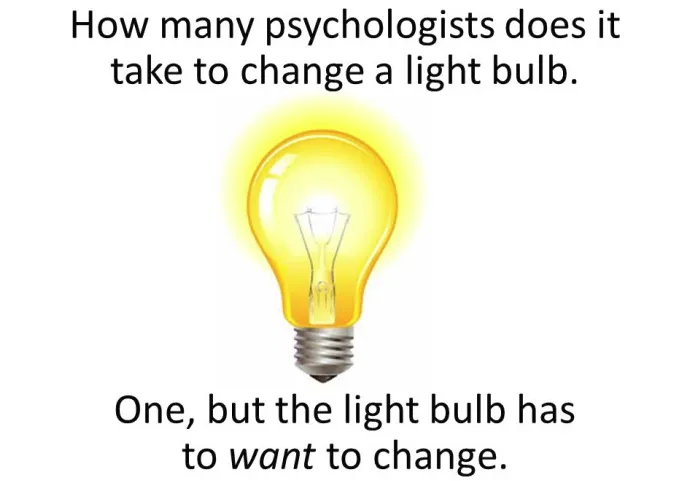
This old psychology joke is the juice behind Key #3.
At the end of the day, matching your offers to the right people is the true secret of great marketers.
This value key doesn’t come into play on the landing page case studies we’re about to look at, but knowing who your right people are is an incredibly important part of writing a landing page that converts.
It’s very important to do the legwork to develop customer profiles and understand why people come to YOU before ever starting to write your landing page.
(Wanting is mostly in play during your audience targeting. On landing pages you’ll mostly see Understanding and Believing elements in play.)
For the sake of brevity, here are 3 guides that will jumpstart you if you’re stuck finding out what makes your customers tick:
If You Don’t Have a “Marketing Strategy”, You Need to Read This
Digital Marketing / 2025-01-24 / by Jamie THE MARKETING NERD
How to Ask Questions That Uncover Your Customer’s Needs
Customer Insights / 2025-01-22 / by Jamie THE MARKETING NERD
How You Can Slay Like Buffy With Customer Avatars
Branding & Positioning / 2025-01-17 / by Jamie THE MARKETING NERD
You can also read more about the 3 Keys to Value here.
Why rattling off a bunch of features doesn’t work…
This next psychological concept is going to be really important in 2 of the case studies we’re going to look at.
Sometimes when we’re really excited about what we do we are SO ready to tell people what the exact modules in our course are, that it comes in blue, that it comes with this free thing…
But is that what your would-be customers care about?
No.
Customers don’t care about your product. They care about themselves.
The difference between listing off a bunch of features versus listing off a bunch of benefits is who the focus is on.
When you spend time on your page telling your prospects that your body butter is made with organic cocoa oil and uses natural scents, that’s about your product. Those are features.
When you spend time on your landing page telling your prospects that your body butter is made with organic cocoa oil so that they can stop struggling with ashy skin, and your product uses natural scents so that they can smell good without putting harmful toxins on their bodies — that’s about them.
Those are benefits.
How do you turn features into benefits?
Well, first make a list of all of the features you’re excited to tell prospects about…
The size is X, the walls a super thick, made with organic ingredients, and so on…
Make a list going vertically on a piece of paper, then draw a line down the middle to divide that side from the blank side.
Next, use the phrase “So that…” and fill in the blank.
So if one of your features was “This body butter is made with natural scents”, you could write “SO THAT you can smell great all day long without any creepy chemicals.”
DON’T just write “cruelty free product”.
That’s just a feature…
DO write “This is a cruelty free product SO THAT you can feel good about what you wear.”
Another tactic is to take one feature and write a little story about how that feature can help someone.
In another marketing psychology article, I used the example of a Swiss Army Knife.
One feature of the Swiss Army Knife is that it’s pocket-sized… Here’s how you can turn that feature into a benefit with a story about how it helped someone:
“Bob was on a camping trip with his children one day. Just him, and his two sons Luke and Trey enjoying some crisp clear water and the great outdoors. After not too long, they got their first carp on the line! It was the BIGGEST carp that Luke had ever caught, and that beast really put up a fight. It took all 3 of them to reel that bad boy in! Luke and Trey get a hold on the wriggling monster, and are trying to hold it still while their dad searches for something to pull the hook out. While Bob is frantically searching their car and their gear bags for the pliers, he has the sinking feeling in his stomach that he must have forgot them at home…. Right as he’s fretting he’ll have to tell his sons that they won’t be able to eat the carp just yet, Bob REMEMBERS something… He threw his Swiss Army knife in his pocket on the way out the door! Because it was so easy to grab his Swiss Army knife without a second thought, Bob’s fishing day with his sons was saved! And they had a happy time for the rest of the day.”
Read more about this exercise here:
The “Brain Glitches” Advertisers Use to Manipulate You Every Day
Marketing Psychology / 2025-01-18 / by Jamie THE MARKETING NERD
Here’s more free information on how to sell with benefits, instead of just rattling off boring features…
How You Sell Without Feeling Like a Scumbag
Sales and Copywriting / 2024-12-29 / by Jamie THE MARKETING NERD
Now let’s look at some high-converting landing page case studies to see these psychological principles in action.
4 High Converting Landing Page Case Studies
Now that you understand the essential psychology behind high-converting landing pages, let’s learn how to apply them!
We’re going to look at 4 real-world case studies of high powered landing pages.
You’ll learn how to make landing pages for free offers, low-cost offers under $100, middle-cost offers $100–500, and high ticket offers of $1000 or more.
How to Make Landing Pages for Free Offers
Whether that free information is a webinar (like in this example), an email course, or a PDF ebook/product sheet/report, one of the most common ways of trying to generate leads is by giving away free information.
The first case study comes from Consulting.com.
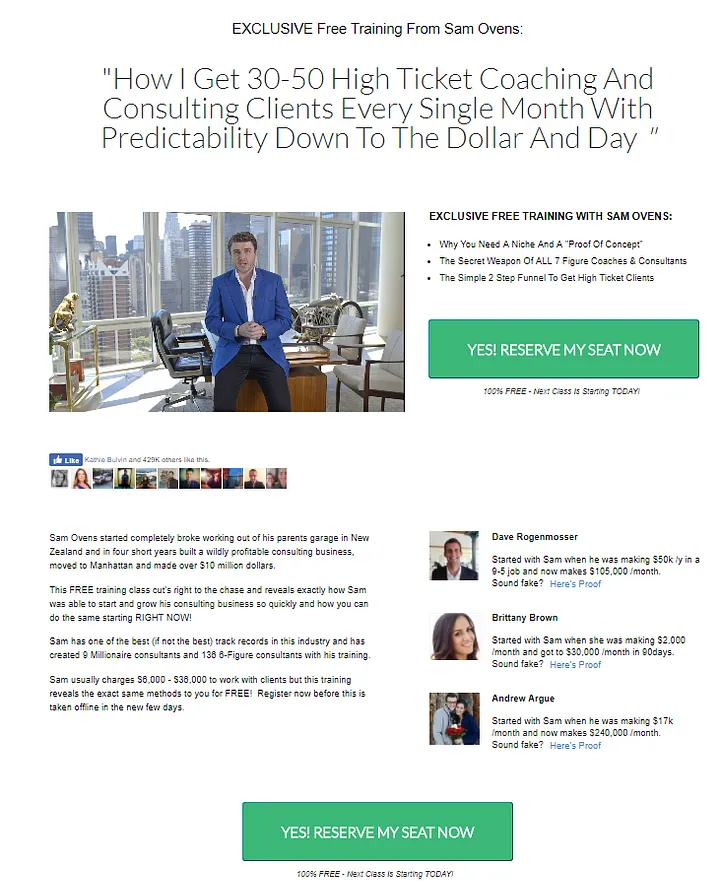
See the landing page here: https://www.consulting.com/webinar
This is a free webinar that’s promoted via Facebook ads. I actually signed up for this webinar myself, which is why I’m so excited to break it down with you.
So what’s going on here? Let’s break it down.
Reciprocity
This is a free webinar. As anyone who’s ever watched a free webinar knows, the presenter usually makes a pitch at the end.
The fact that you get this 2 hours worth of information for free makes you feel obligated to at least listen to the offer presented at the end.
This free webinar is actually the lead generation method for Consulting Accelerator, a $1,997 product.
This lead generation method is obviously working for him, because he has 3,213 sales of the very expensive product!
Commitment & Consistency
Remember, the commitment/consistency influence principle has to do with how the prospect sees themselves.
People who want to work for themselves would like to think of themselves as the kind of person who can book 30+ clients.
The auto-playing video is another element that creates commitment. After you’ve spent some time watching the video, it’s easy to continue and look at the rest of the page because you’re acting consistently along with what you just did. (Paying attention to the video.)
Liking
In the body copy millionaire Sam Ovens shares his own rags to riches story of starting his business in his parents garage.
Normal people who weren’t born into wealth like to know that this guy started off in the same place they did.
Another factor of his likability (or trustworthiness) is his accent.
According to a psychology study out of Brigham Young University:
The final element that enforces the liking principle is the 3 featured case studies down the right hand column. These look like average people, not rockstars. They are also paired with videos so you can see that the photographed everyday looking people are actually the ones who have these results.
Authority
The first authority signals come from the video itself. The video isn’t being recorded in some studio, it’s being filmed in his own office. (You can tell the office is real and not a green screen because he’s leaning against the desk.)
The other element that adds to the authority effect is the body copy “creating 9 Millionaire consultants and 136 6-figure consultants with his training.”
Social Proof
The 3 case studies that link out to video testimonials also add social proof, in addition to likability.
There is also the Facebook widget under the video displaying that “429K people like this”. (The Facebook widget may also add to likability when it pulls out the names and photos of “Your friends and 429k others like this”.)
Scarcity
Can you create scarcity with a free offer?
Yes.
Notice that the word “Exclusive” is hammered on twice in the copy, and in the autoplaying video itself.
You can see a slight element of scarcity in the under-button copy “Next Class Is Starting TODAY!”.
Scarcity is also introduced in the body copy with the blurb “Sam usually charges $6,000 — $36,000 to work with clients”.
What else is going on?
The other element super powering this landing page is its great design.
The most important information is above the fold (meaning it’s immediately visible on the page load).
There is quite a lot of information packed into this landing page, but it doesn’t feel overwhelming.
There is a second call to action at the bottom to catch anyone who wanted to look at the other information.
The final element that enforces the liking principle is the 3 featured case studies down the right hand column. These look like average people, not rockstars. They are also paired with videos so you can see that the photographed everyday looking people are actually the ones who have these results.
Authority
The first authority signals come from the video itself. The video isn’t being recorded in some studio, it’s being filmed in his own office. (You can tell the office is real and not a green screen because he’s leaning against the desk.)
The other element that adds to the authority effect is the body copy “creating 9 Millionaire consultants and 136 6-figure consultants with his training.”
Social Proof
The 3 case studies that link out to video testimonials also add social proof, in addition to likability.
There is also the Facebook widget under the video displaying that “429K people like this”. (The Facebook widget may also add to likability when it pulls out the names and photos of “Your friends and 429k others like this”.)
Scarcity
Can you create scarcity with a free offer?
Yes.
Notice that the word “Exclusive” is hammered on twice in the copy, and in the autoplaying video itself.
You can see a slight element of scarcity in the under-button copy “Next Class Is Starting TODAY!”.
Scarcity is also introduced in the body copy with the blurb “Sam usually charges $6,000 — $36,000 to work with clients”.
What else is going on?
The other element super powering this landing page is its great design.
The most important information is above the fold (meaning it’s immediately visible on the page load).
There is quite a lot of information packed into this landing page, but it doesn’t feel overwhelming.
There is a second call to action at the bottom to catch anyone who wanted to look at the other information.
How to Make Landing Pages for Low-cost Offers ($100 or Less)
This next landing page case study comes to us from Stealth Flashlights.

I didn’t buy this myself, but I wanted to feature it because I thought it was funny to see Stealth sell a flashlight for ~$54 that you can buy from Amazon for $12.
They’re driving traffic from Facebook advertising to this landing page:
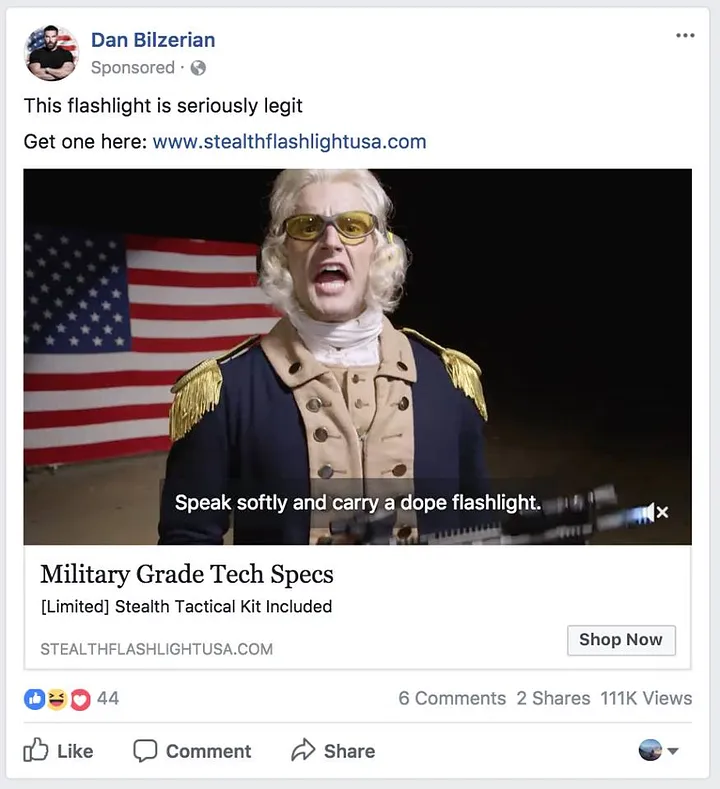
So what’s going on here? How can you make landing pages for your own products/services that are $100 or less?
Scarcity
The biggest point hit on with this landing page is scarcity.
Above the fold alone there are 3 elements that draw on scarcity:



2 of the calls to action further down the page also hit on scarcity with the under-CTA copy “Limited stock remaining — Act fast to avoid disappointment.”

Authority
This offer is really banking off of the authority of survivalist thought leader Dan Bilzerian.
Going back to the Facebook ad that’s driving traffic, look who’s page is actually the one promoting the product…

Plus there is his quote featured underneath of the video:
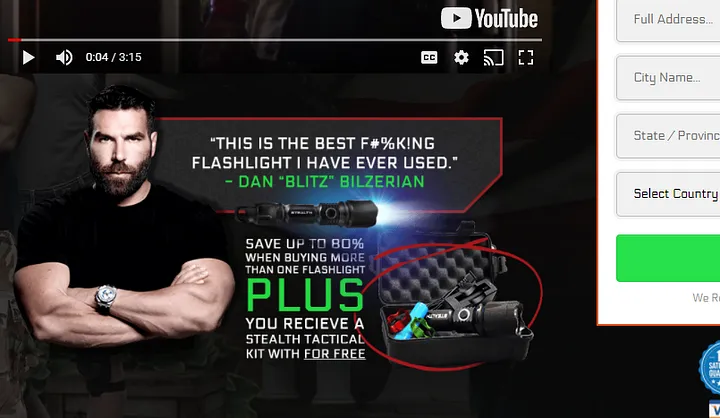
Going back to the toothpaste/dentist commercials, “borrowed” reputation is one of the most common ways that marketers try to influence you.
The autoplaying video also adds to the authority. Even though it’s (obviously) an actor, note that the first thing you hear immediately after loading the page is “Hey, I’m George Washington.”
You can see the Harmon Brothers-esque ad here:
Commitment & Consistency
Above the fold there are 2 elements that rely on instilling a feeling of commitment and consistency.
Again, we see an autoplaying video as a way to get you already interacting with the page so that continuing to view the page is just a continuation of your previous action.
The other commitment element is the 2-step purchase form.
With lower priced offers, it’s not actually a bad thing to put the information of price out there sooner (rather than later).
If someone can quickly decide that they can spend ~$50, you want to get them starting the checkout process as soon as possible.
By asking for the “easy” information like name and address first, you make it feel easy to begin the checkout form.
Once clicking “continue to next step”, it’s unlikely that someone will stop something they’ve already started. They will more likely complete the form to be consistent with their first action (filling in step 1).
Social Proof
The next most prominent influence principle is social proof.
While you browse the landing page Stealth uses a plugin called Proof to have popups that show you the name and state of people who purchased the product.

Plus, you have the Dan Blitz quote underneath the video acting as social proof:

Liking
Yes, Stealth is banking on people liking Dan Bilzerian to sell its product.
Another element that tries to capitalize on the liking principle is the conversational copy used throughout the landing page.
Dan’s quote is not “This flashlight is amazing”, it’s “THIS IS THE BEST FUCKING FLASHLIGHT I’VE EVER USED.”
The headline underneath the form isn’t “Why is the flashlight good?” it’s “So what makes the tactical flashlight so damn good?”

The on-page language makes it clear that the target demographic is the “survivalist bro”.
This flashlight isn’t packed with features, it’s fully loaded with badass features.
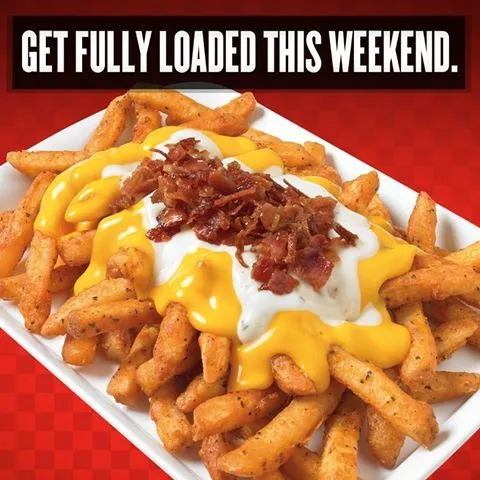
Reciprocity
Finally, there are 2 big reciprocity elements going on here.
The first is actually the discount above the fold:

The second is the free gift stealth tactical kit.
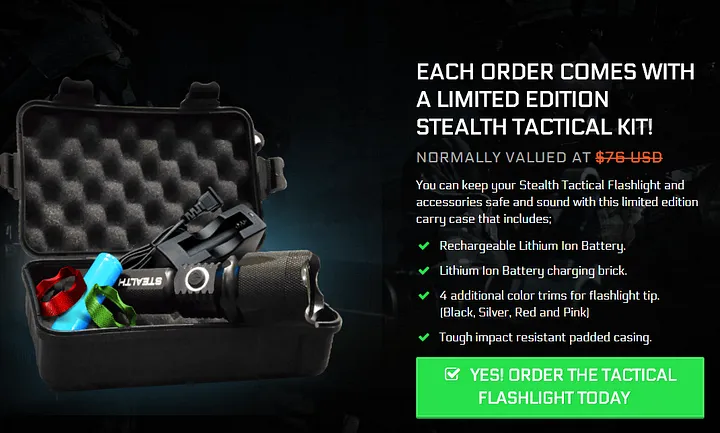
What else is going on?
Specs that will make your brain melt. This landing page is an excellent example of the difference between features and benefits, like we discussed earlier.
It doesn’t just say “Glass breaker, USB charger, bottle opener”… The landing page helps illustrate why a survivalist bro would benefit from these features in their life:
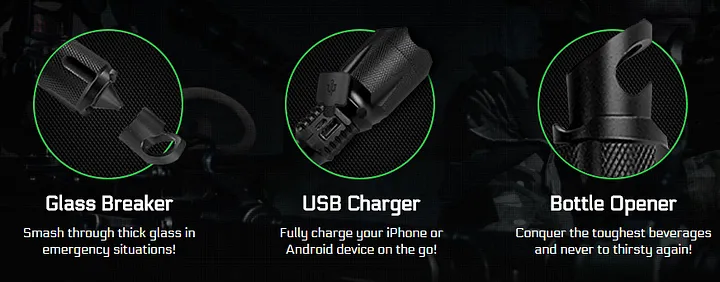
Finally, this landing page also features a low friction design that makes it easy for customers to find what they’re looking for.
The call to action is above the fold, which is always good. There are also 4 calls to action total, 3 lower down on the page after the order form.
How to Make Landing Pages for Middle-cost Offers ($100–500)
The next case study will be perfect for entrepreneurs trying to middle-cost offers between $100–500.
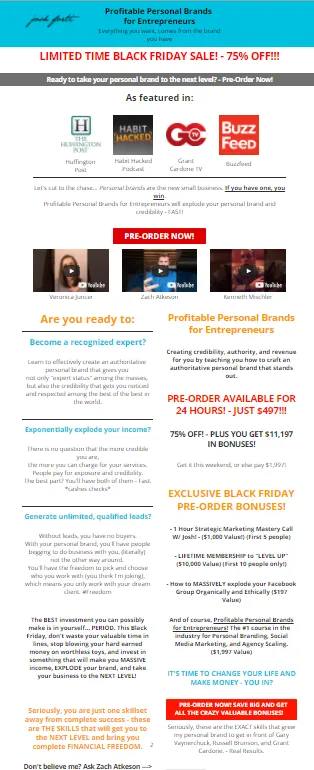
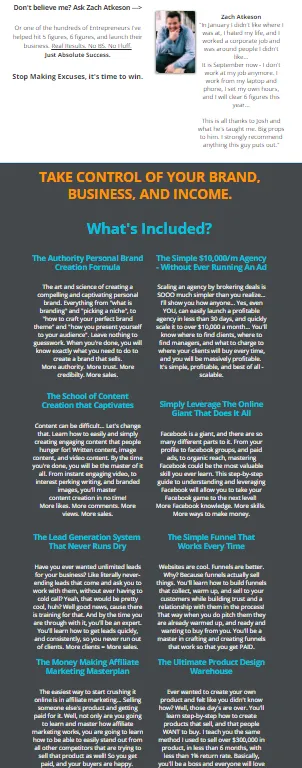
This landing page is for Profitable Personal Brands for Entrepreneurs by Josh Forti.
This is another one of the products that I’ve actually bought myself, from this Facebook post:
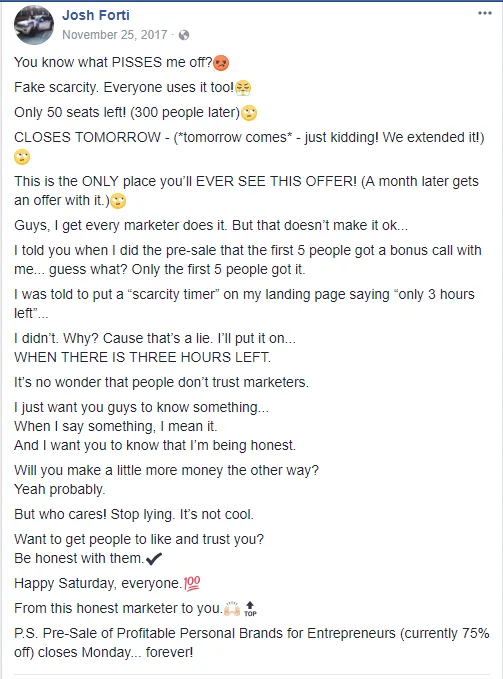
Now let’s dig into what’s going on!
Reciprocity
There are quite a few elements contributing to the reciprocity principle here.
There are several free bonuses detailed.
There is also a significant discount for pre-ordering, which feels like money that’s “given” to you because it’s positioned as saving $1,500 on the material.
Scarcity
Probably the biggest driver of this landing page are the scarcity elements.
In addition to strengthening the reciprocity effect on this page, the Black Friday/pre-order angle adds to the scarcity too.
The popup that loads when you land on the page also adds to the scarcity effect.
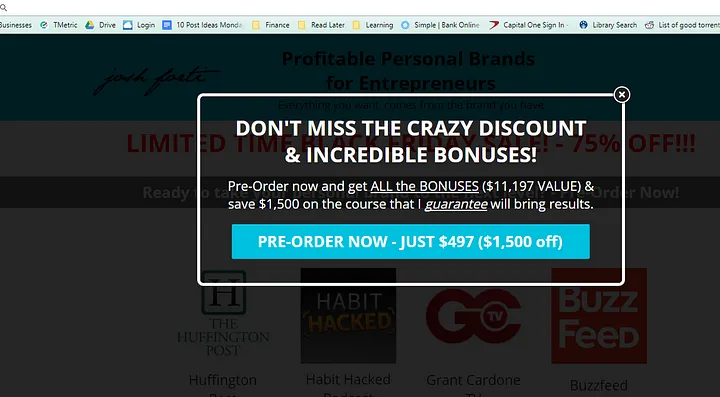
The under-CTA copy “Get it this weekend, or else pay $1997” is another ringing the alarm bell scarcity element.
The bottom CTA also takes the scarcity angle:

Commitment & Consistency
Remember, the commitment & consistency principle is related to how the prospect thinks about themselves.
There are quite a few places in the copy that hit on this “Who you think you are” principle.
At the top the phrase “Everything you want, comes from the brand you have” has a very powerful effect, especially on people like me who watch a lot of Gary Vee talking about how brand is everything.
There are a few large copy sections that deal with “readiness”. Calling out to people who are “ready to take your brand to the next level”.
The body copy asking “are you ready to” become a recognized expert, exponentially explode your income, generate unlimited qualified leads are all easy to say yes to.
Anyone who wants to grow their business wants these things for sure.
There is also the block “The BEST investment you can possibly make is in yourself… PERIOD. This Black Friday, don’t waste your valuable time in lines, stop blowing your hard earned money on worthless toys, and invest in something that will make you MASSIVE income, EXPLODE your brand, and take your business to the NEXT LEVEL!”.
I, and others who are good targets for this product, like to think of ourselves as people who are always trying to grow.
All of this copy is totally congruent with how I see myself, or what I want for myself — so it’s easy to say yes to.
Authority
We’re back to the good old fashioned “As Seen On” authority logos here.
The “Grant Cardone TV” logo pulls double duty, because it’s a reputable outlet that has the name of a popular thought leader — so it’s almost like a double thumbs up from Grant Cardone himself and his Cardone Media PR brand.
He also does a lot of associating himself to niche thought leaders with the under CTA copy “Seriously, these are the EXACT skills that grew my personal brand to get in front of Gary Vaynerchuk, Russell Brunson, and Grant Cardone. — Real Results.”

Liking
The video testimonials at the top are from pretty regular looking people. The fact that you don’t have to be a superstar to see results with this program is something that can be very compelling to someone like me, who is also not a superstar.
There is also an aspect of playing off of people’s “like” for some of the niche figures brought up in the page, especially Grant Cardone because of the prominent feature of the Grant Cardone TV logo up top.
Gary Vee, Grant Cardone, and Russell Brunson all have extremely developed fan bases, so in addition to associating himself to these figures Josh is also playing off of the fact that I like them by drawing them into the copy.
Social Proof
In addition to contributing to liking and authority, both the video testimonials and the “As Seen On” badges contribute elements of social proof.
What else is going on?
Going back to the 3 keys to value, Josh does a great job of hitting on Understanding and Believing.
Too often landing pages stop at the bullet points like “Become a recognized expert”. It’s true that most of us probably have a mental image of what a “recognized expert” is, but Josh’s landing page goes the extra step of spelling out the exact benefits so you can fully understand the impact that this change will have in your life.
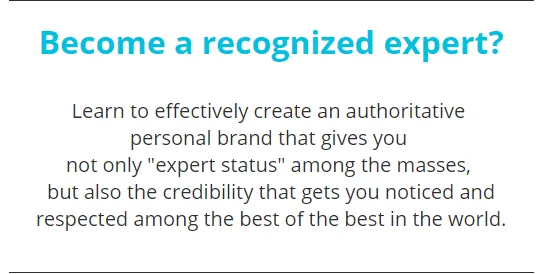
The “What’s Included?” section also does a great job of going into specific detail about each of the modules. You can’t just write “Engaging Content Module” and expect prospects to know exactly what you have in mind. When Josh is writing about each of his modules you know the topic, what skills are going to be taught, and the outcome of learning those skills for your situation.
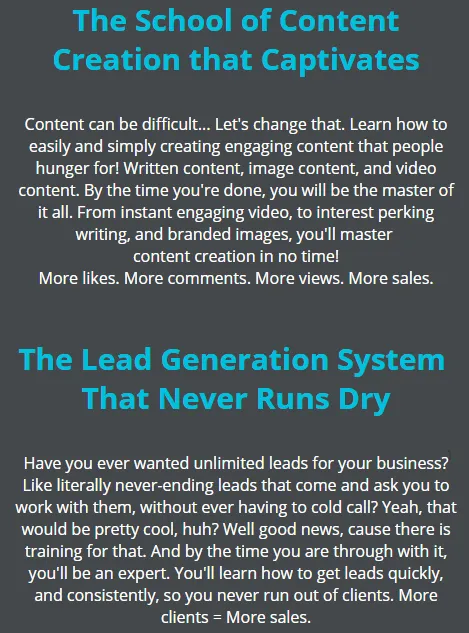
Josh’s landing page really focuses on how skillsets are the vehicle that can get you to your goals. There’s no woo, no “manifesting”, and no “some people are born with it and others aren’t” which does a great job first of helping people believe that the material actually works.

The belief elements are very powerful when combined with all the testimonial material. There are also plenty of examples of language on the page that makes you believe the results you’re looking for are within your reach:



How to Make Landing Pages for High-cost Offers ($500–1000+)
The last case study is a study of high-ticket offers and it comes to us from Jon Benson.
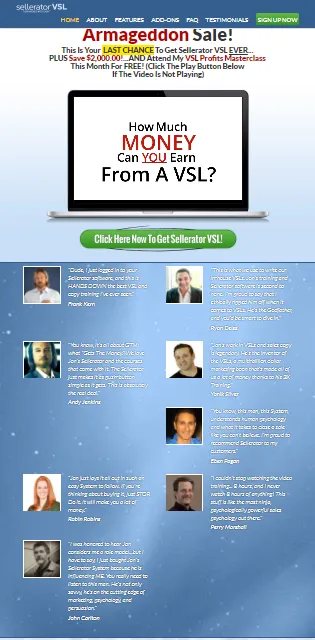

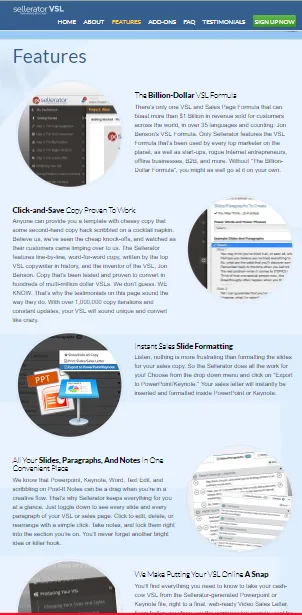
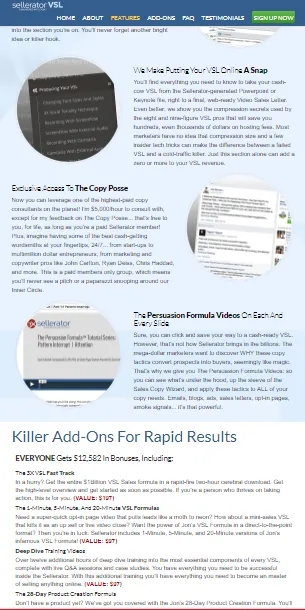
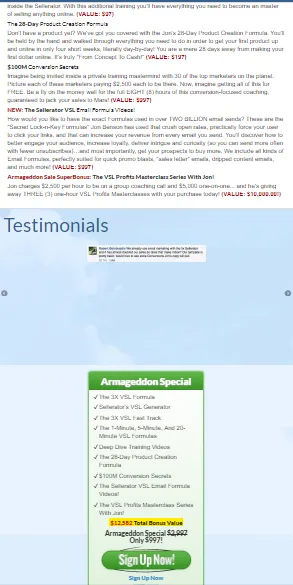
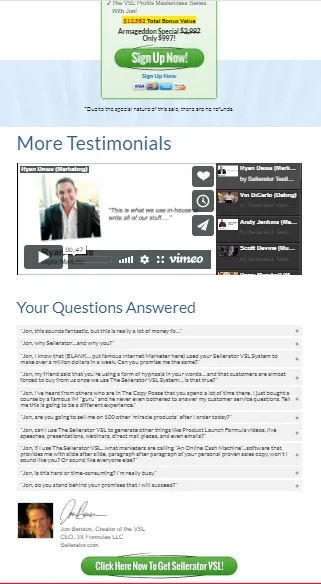
The way this sales page is being promoted is pretty interesting. He’s using Facebook ads to drive traffic:
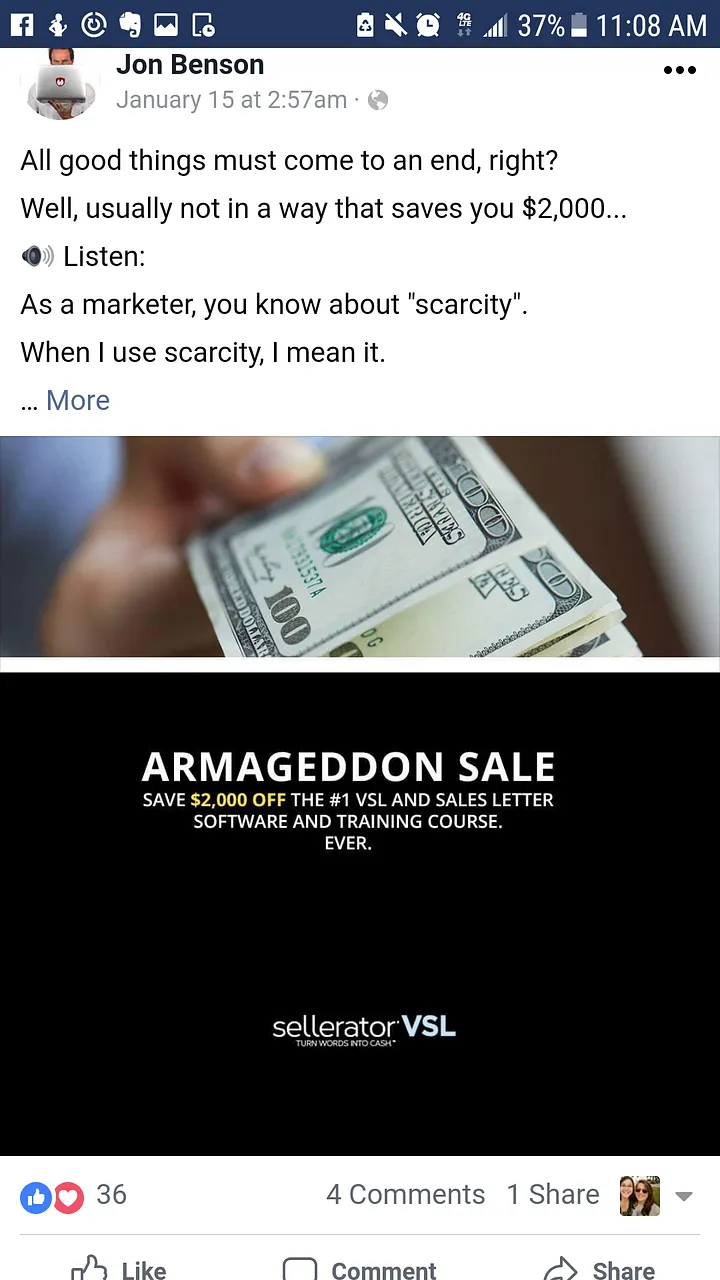
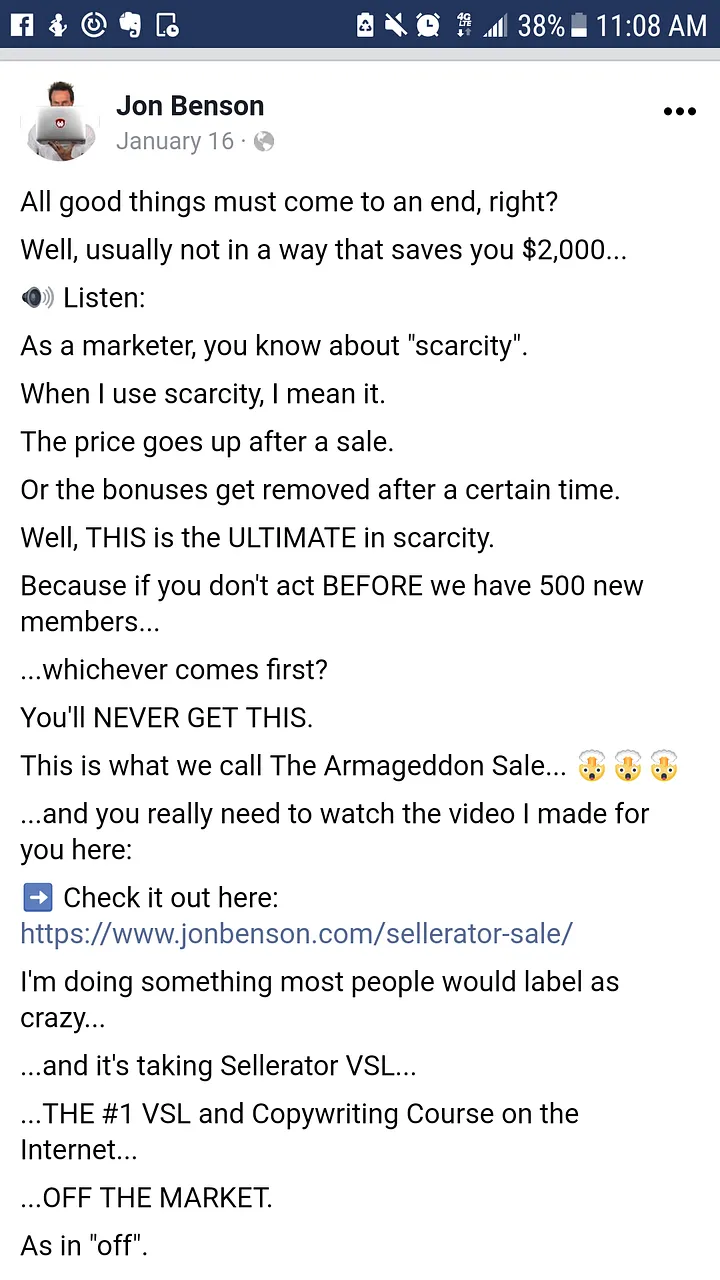
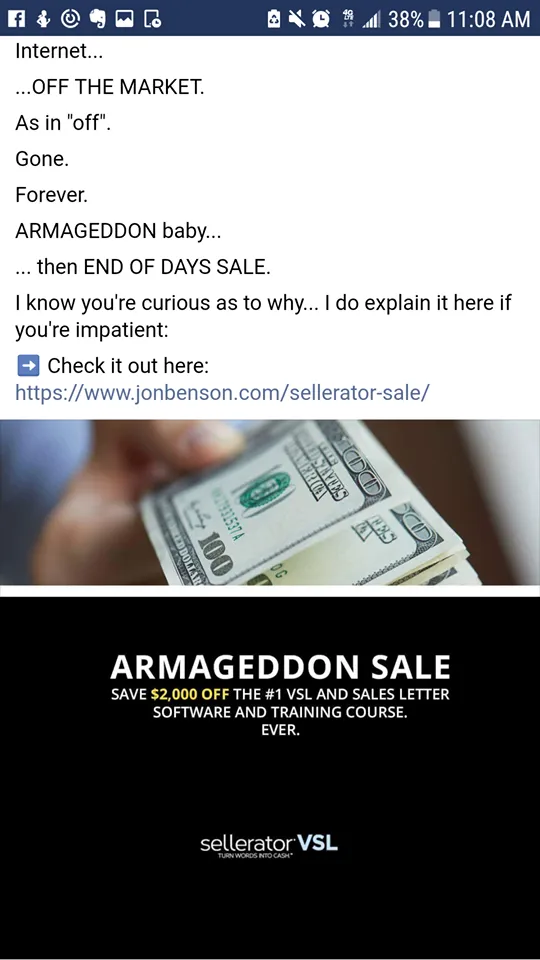
And he’s also using affiliate relationships to drive traffic to the page through email:
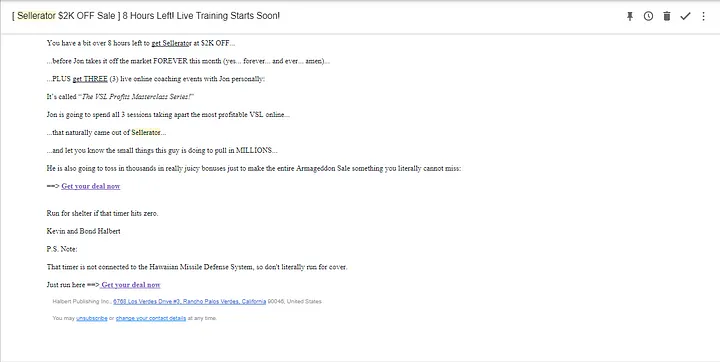
Caption: This affiliate email comes from Kevin & Bond Halbert, the sons of copywriting legend Gary Halbert.
So what’s going on in this landing page?
Scarcity
The first elements in play above the fold is scarcity. It’s all over the headline with language like “last chance”, “save $2000”, and the masterclass free gift:

Even the name Armageddon Sale elicits scarcity.
Another prominent scarcity element is the countdown ticker at the bottom of the page:
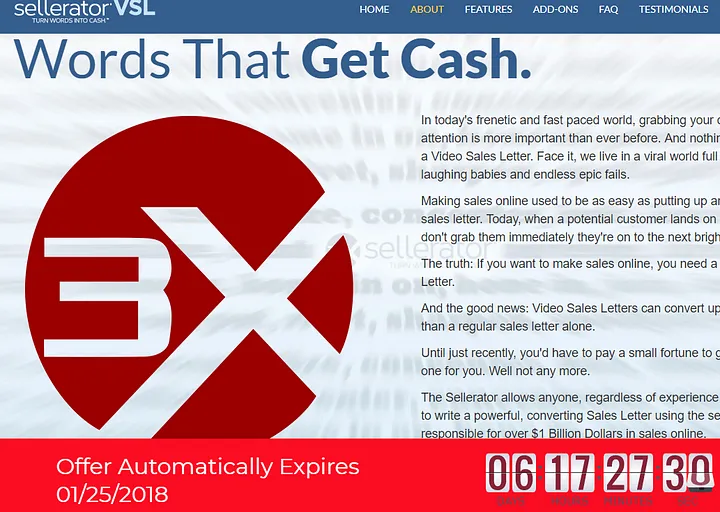
There are also some time-restricted bonuses that are hit on underneath of the calls to action:

Commitment & Consistency
Hello autoplay video my old friend…. I’ve come to talk with you againnn….
Authority
To mash on the authority button prospects are greeted with 8 glowing testimonials from some of the biggest authority figures in marketing like Ryan Deiss, Frank Kern, Yanik Silver, Eben Pagan, John Carlton, and Perry Marshall. This gives Sellerator “borrowed authority” from these thought leaders:
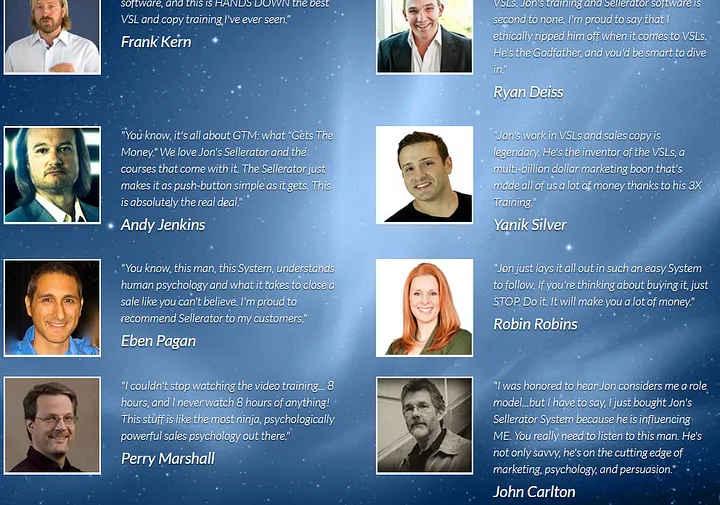
Reciprocity
There are actually a ton or reciprocity elements in play here that add to the compellingness of the landing page.
Starting back at the headline, there’s the feeling that you’re almost being “given” $2,000. And the mention of the free gift masterclass.

Then there is just the totally massive list of free gifts that come along with the package.
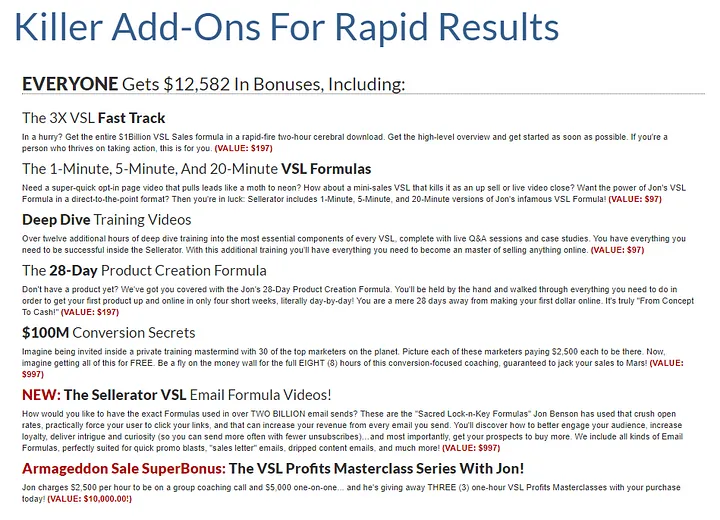
What’s great about the way this is laid out is that the value of the gift is quantified at the end of each description. Then all of the “values” (which are pretty arbitrary) get added up to be “12,582 worth of bonuses” that you’re being given.
This $12,000 number anchors you to a really expensive price. This “anchor price” comes into play again with the 2nd/main call to action:
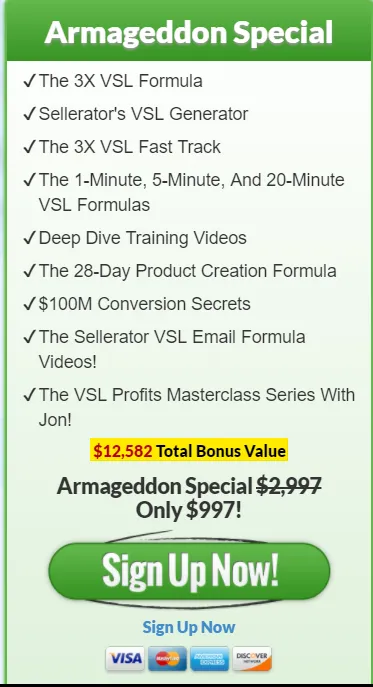
Liking
In addition to the testimonials from some of the biggest figures in marketing, the Facebook testimonial slider does a good job of showing the prospect that you don’t have to be a superstar to see these results.
Those Facebook posts say here are people just like you and here’s what they’re saying.
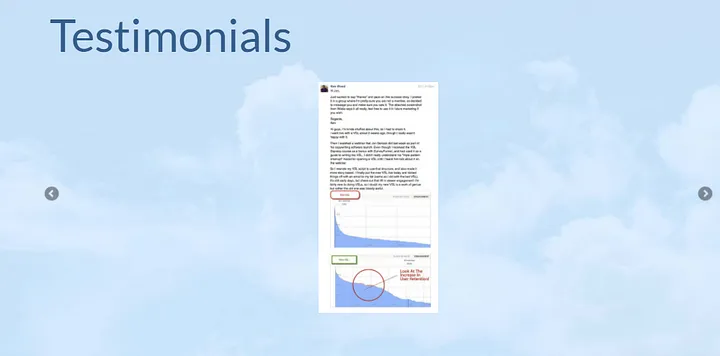
Social Proof
There are literally MORE THAN 40 TESTIMONIALS tucked away in this page. Social proof is being heavily, heavily leaned on in this page between all of the authority figure written testimonials, everything in the testimonial slider, and all 37 of the video testimonials at the bottom.
What’s Different When Promoting Low-cost and High-cost Offers?
Maybe you’ve noticed a few patterns while looking at these 4 case studies 🙂
Although there are a lot of similarities in high converting landing pages across these different offers, there are also some things that are different depending on the cost of the offer.
Length
High-cost offers take a lot more explaining to sell than free or cheap offers.
You’ll notice about 2+ extra pages of content for every price jump in the case studies we’re looking at.
The free webinar offer is essentially a 1 pager, the Stealth Flashlight needs 4 pages, the Profitable Brands needs 6, and the $1,000 Sellerator product needs 9 pages to explain its value. (The only reason Sellerator only needs 9 pages is because it seems to be promoted to audiences who are already familiar with the product, or who are in general very advanced copywriters/marketers who already know what a video sales letter is. If this promotion was going out to an audience that wasn’t as familiar with VSLs or with Jon Benson as a figure, it would probably have to be even longer.)
Testimonials
While testimonials are nice to have, there are some pretty distinct differences in how low-cost products use them compared to how high-cost products have to use them.
The free webinar offer did have several on-page video testimonials, that’s true. (Although if you listen carefully you’ll notice that the video reviews are actually for his $1997 Consulting Accelerator product, and not exclusively video testimonials for the webinar…)
The Stealth Flashlight product didn’t have any testimonials at all, because it’s not really necessary at a $60 price point.
But when you jump to the $1,000 Sellerator product? WHAM-BAM 8 testimonials upfront with another ~7+ Facebook screenshot testimonials, and then another 37 VIDEO TESTIMONIALS at the bottom!
Timing of Price Reveal
You’ll notice that in general the lower the cost, the sooner the price is revealed to the prospect.
Free webinar? FREE is plastered all over that page.
$60? The price is actually in the headline (with an essentially “fake” suggested retail price that’s crossed out to anchor you to that higher price).
$500? The price is on the page after you scroll past the video testimonials and authority logos at the top.
$1000? That part isn’t revealed until the 2nd page 🙂 (Or allllllllll the way to the bottom right above the tens of video testimonials for the REALLY dedicated readers.)
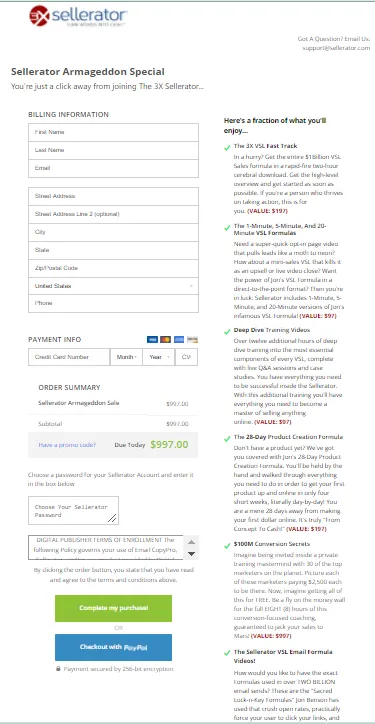
So… Now What?
After reading this guide you should be a regular landing page detective. You should now be able to look at your own landing page and see at least 3 things you can improve right now. (If you still aren’t sure, I can help you optimize your landing page.)
First, bookmark this page now.
There’s A LOT of information here and you’re not going to absorb it all in 1 day.
Bookmark this page and review all of the influence principles. Take the time to make sure you understand what’s going on and study the landing pages we used as case studies on your own.
Keep this guide close whenever you’re writing a new landing page, or when you’re optimizing your existing landing page for a jumpstart on brainstorming.
